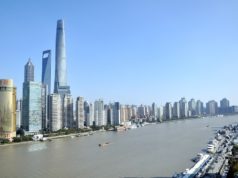Singapore MAS Gillian Tan APAC Risk Conference Keynote Speech: 6.2 Million Lives Lost, APAC Developing Economies Lost $2 Trillion
28th April 2022 | Singapore
Singapore central bank Monetary Authority of Singapore (MAS) Gillian Tan (Assistant Managing Director, Development & International) gave a keynote speech at the Asia-Pacific Risk Virtual Conference hosted by Risk & Insurance Management Society (RIMS) & Willis Towers Watson (WTW) on the 26th April 2022, touching on key issues including 6.2 million lives lost due to the pandemic, Asia-Pacific developing economies losing $2 trillion, pandemic risks, climate risks, and capabilities and opportunities for the insurance & finance sector. Monetary Authority of Singapore (MAS) Gillian Tan: ”The theme of the conference, Risk Resilience Reimagined, is a timely reminder of the importance of building our capabilities to navigate complex risks … … More than two years on, the pandemic continues to evolve and impact health, lives and livelihoods. And scientists are certain that this won’t be our last pandemic.” Read the full key note speech below:
“ 6.2 Million Lives Lost, APAC Developing Economies Lost $2 Trillion “
Monetary Authority of Singapore (MAS) Gillian Tan, Assistant Managing Director (Development & International) Keynote Speech
Asia-Pacific Risk Virtual Conference (Risk & Insurance Management Society (RIMS) / Willis Towers Watson (WTW)

Introduction
1 Thank you for inviting me to join you this afternoon. The theme of the conference, Risk Resilience Reimagined, is a timely reminder of the importance of building our capabilities to navigate complex risks.
New Uncertainties in an Uncertain World
2 We are gathered here in unsettling times. The war in Ukraine has cost lives, led to a refugee crisis, precipitated an unprecedented global response and brought about profound new uncertainties in an already uncertain world.
- There will be stresses on the world’s financial, energy, food and commodities markets – just last month, the price of crude oil hit a 14-year high, increasing by more than 70% compared to a year agoSource: The International News: Brent crude soars to a near 14-year high of $140 per barrel, March 2022.
- Macroeconomic policy, already in a tough spot, is now more difficult, because it is no longer just about shocks to inflation, but also about shocks to growth, and the social instability that could come about, as a result of not managing these pressures well.
3 All this has come at a time when the world economy is still fragile, fresh from recent battles with the COVID-19 pandemic, which exacted a heavy price.
- Over 6.2 millionSource: Worldometers, April 2022 lives are estimated to have been lost.
- The pandemic was not only a health crisis. APAC’s developing economies experienced nearly US$2 trillion in economic losses between 2020-2022Source: ESCAP, Economic and Social Survey for Asia and the Pacific, 2022.
- Even today, more than two years on, the pandemic continues to evolve and impact health, lives and livelihoods.
4 And scientists are certain that this won’t be our last pandemic.
- On average, over 200 epidemic outbreaks and five emerging infectious diseases are reported annuallySource: Munich Re, Epidemic and Pandemic Risk Solutions .
- And the gradual deterioration in the commons, loss of biodiversity and increased incursions in the natural world have led to a higher incidence of zoonotic spillovers, leading to a growing frequency of pandemics.
5 And then there is the urgent need for climate action. Here, the science is clear. Our actions and inactions have consequences.
- The changing climate is bringing about rising sea levels and a higher frequency of extreme weather events. These threaten to displace lives, livelihoods and communities, with economic and social consequences that come with a hefty price tag.
- This is especially pertinent in Asia, which is geographically prone to natural catastrophes. The costliest natural disaster in 2021 was the flood in Henan province last July which resulted in a total economic cost of over US$2 billionSource: Asia Insurance Review, Insured losses from Henan floods approach US$2bil, September 2021 as of September last year, and this number is only expected to head north.
- These weather extremes will continue to occur, causing cascading impacts that will become increasingly difficult to manage.
6 Amidst this sobering backdrop, what has been taken for granted all along is now clear: our interconnected and interdependent global system is incredibly fragile and vulnerable.
Demand for Resilience Capabilities and Opportunities for the Insurance and Finance Sector
7 It is therefore no wonder that countries, communities and corporations are keen to build resilience capabilities across multiple dimensions – human, financial, operational and technological.
- Past investments in digitalisation, for instance, were critical in enabling Singapore’s financial sector to pivot to remote working, thereby ensuring the continued delivery of services through the pandemic.
- We also see new embedded finance partnerships emerging, aided by digitalisation, as insurers partner tech players to deliver financial services to a bigger and broader audience.
- Human capital has also emerged as a key differentiator in the pandemic. Offering flexible hybrid work models, investing in employees’ wellbeing, and upskilling them to prepare for the digital and sustainability economy will be important in attracting and retaining talent.
8 Beyond these resilience capabilities, which all governments and corporates need to urgently develop, there will be opportunities for insurers and reinsurers to help build societal and corporate resilience and manage ever-present risks.
9 Let me describe two of the most significant risks, the challenges and opportunities for the finance and insurance sector, and how Singapore seeks to support necessary efforts in each area.
Pandemic Risks
10 First, in the area of pandemic risks.
11 While economies have relied on government budget stimulus measures and relief schemes, this has taken a significant toll on fiscal balance sheets and has often come at the expense of much-needed government expenditure in other areas such as climate.
12 If we are to learn to live with COVID and other pandemics, we will need to put in place measures to build longer term financial resilience to such events.
13 Insurance can be particularly effective in cushioning the economic disruption from such outbreaks. The insurance industry has begun to adapt and we now see more coverage for pandemic disruption. Three of the top five insurers in Singapore, for instance, offer insurance for event and travel cancellation to help mitigate the risk of disruption of plans from mandated closures or lockdowns.
14 More needs to be done, however, in improving the affordability, accessibility and quality of business interruption insurance, to make it better suited to the needs of businesses. Such covers are often an add-on to property insurance, and pay-outs are tagged to physical damage to property, which means that business interruption due to a pandemic is not covered, or is expensive and limited in scope.
15 As a flood of claims triggered on a global basis by fast spreading pandemic variants pose significant challenges to making pandemic risk insurable, a more resilient approach for economies and businesses is to support pandemic risk sharing and risk pooling. Pandemic risk financing for critical or more vulnerable sectors through a public-private approach, combining finances from the government, key firms in these industries, and insurers could provide much-needed rapid relief.
16 Beyond innovative approaches, the availability of data will take these efforts further, ensuring more efficient, seamless and effective coverage.
- The pandemic has provided the insurance and risk modelling industry good data points on relevant factors impacting business continuity across countries and sectors, and further risk analytics and modelling can support more customised solutions.
17 Policy makers and corporates can also benefit from exchanging insights with the financial services industry on behaviours and policies which better promote pandemic resilience in businesses (including business continuity plans and greater digital adoption). Through incorporating such behaviours and expectations as part of their underwriting, insurers can also incentivise better pandemic risk management.
18 Singapore is taking active steps towards building stronger capabilities in pandemic risk financing. A key platform is the Global-Asia Insurance Partnership or GAIP, which is a tripartite partnership between the global insurance industry, regulators and academia. It aims to produce actionable research insights, develop policy recommendations and co-create innovative solutions for key risks that Asia faces. Pandemic risk has been identified as one of the focus areas for GAIP.
Climate Risks
19 Let me now turn to climate risks.
20 Climate risks will result in structural shifts to companies’ risk-return profiles. More frequent catastrophic events can cause severe impairment to business models, lead to substantial income and productivity losses, and make certain tail risks uninsurable or insurable only at unaffordable rates.
- By some estimates, if no action on climate change is taken, Asia’s economy would be 26% smaller by 2050, whilst ASEAN’s economy would be 37% smallerSource: Swiss Re Institute, Economics of Climate Change, 2021.
21 The problem of underinsurance can already be seen.
- In 2021 alone, the economic cost of catastrophes in the Asia Pacific region was US$50 billion, accounting for 18% of the global total. However, Asia is significantly underinsured at only 17% of the total economic cost compared to the global average of 57%.Source: South China Morning Post, Natural disasters cost Asia-Pacific US$50 billion last year, of which just US$9 billion was covered by insurance, says Munich Re, January 2022
22 Asia’s insurance markets are growing, but the pace of growth will not be able to match the region’s growing protection needs from natural catastrophes. A distinct lack of high quality and standardised data to accurately quantify risk exposure for climate risks or to build reliable models also remains a key challenge.
Risk Financing for Physical Climate Risk
23 To support natural catastrophe risk financing in the region, Singapore has been stepping up efforts to support the development of innovative risk pooling solutions as well as better risk modelling and analytics capabilities. We see insurance-linked securities or ILS, which support additional fund raising from the capital markets, as a key solution.
- Asia’s ILS market is growing, as more cedants, both sovereign and corporates, look to such vehicles to raise additional risk capital.
- Singapore is now a leading domicile for ILS issuances in the Asia Pacific. As of June 2021, our ILS market share was 14%Source: Aon ILS Annual Report 2021. There was a total of 7 ILS transactions from 30 June 2020 to 30 June 2021 from Singapore, out of a global total of 51 issuances. of the global market. 21 ILS transactions have been launched in Singapore since 2018, including a growing number of transactions by Asian cedants, covering multiple perils such as typhoon, flood and cyclone risk in Asia.
- Singapore will build on this momentum and anchor capabilities in ILS structuring, risk modelling, loss reserve adjustments, and fund management to better support corporate and sovereign cedants in the Asian time zone. We are also working on enhancing our regulatory, corporate, tax and bond listing regimes to support a wider range of ILS risks and instruments.
24 Ultimately, supporting the growth of better climate risk financing solutions will require strong risk analytics, data and risk modelling efforts. We need to share resources, exchange notes and work together.
- There is also strong and broad ranging regional cooperation to enhance Asia’s resilience in climate and disaster risk. One example is the ASEAN Disaster Risk Financing and Insurance programme (ADRFI), which will leverage the expertise of academia, governments and the industry to construct a high resolution and objective natural catastrophe database. This will improve the quality and availability of natural catastrophe risk data and analytics.
Green and Transition Risk Financing
25 What else can the insurance community do? As risk financiers, insurers provide risk financing which is instrumental to the functioning of key sectors and infrastructure, including the energy and chemicals, aviation and shipping sectors. Some of these sectors form a sizeable part of global and Asian economies but are not inherently “green”. Risk financing and insurance can be an important lever in engaging the relevant stakeholders and supporting a progressive low-carbon transition of these sectors.
26 As part of the underwriting process, insurers can work closely with their clients in these sectors, to understand and engage them on their climate risk exposures, transition plans and pathways, and support them with risk management analytics and insights. Ideally, insurers should journey alongside clients so that they make concrete and progressive improvements in their environmental performance over time.
- It has been heartening to see insurers stepping forward in their support of the Poseidon Principles for Marine Insurance, launched in December 2021.
- This sets a framework for responsible insurance practices in the maritime sector, whereby insurers engage with their clients and promote environmental stewardship and push for meaningful decarbonisation.
- This, in turn, supports the International Maritime Organisation’s target of peaking greenhouse gas emissions from international shipping as soon as possible, and halving total annual emissions by 50% as compared to 2008Source: International Council on Clean Transportation (ICCT), IMO’s Carbon Intensity Target Could be The Difference Between Rising or Falling Shipping Emissions This Decade, May 2021.
27 Beyond transition sectors, insurance provides important risk capital for the growing green economy.
- As the region increasingly invests in solutions including carbon capture, renewable energy generation and the production of future fuels such as hydrogen, insurance can help overcome some of the friction, uncertainty and risk involved in deploying such much-needed infrastructure and in facilitating investments in these areas.
Stewardship and Transition
28 The insurance industry is also a sizeable investor, accounting for US$35 trillionSource: Cambridge Institute for Sustainability Leadership, ClimateWise Research, 2021 in total assets under management.
- According to a BlackRock study, 95% of global insurers believe that climate risk is investment riskSource: Blackrock’s 10th Annual Global Insurance Report, November 2021.
- Insurance investors are increasingly embedding sustainability in their investment processes and strategies, and also reallocating existing assets to sustainable investments to generate better risk adjusted returns.
29 Singapore is developing deep expertise and capabilities in sustainable and climate investing, with a strong focus on use cases for Asia. We encourage the insurance and financial services eco-system to tap on our sustainable finance centres of excellence, such as the Singapore Green Finance Centre, and the Sustainable and Green Finance Institute, either for training in sustainable investing, or to co-create research on sustainable investment approaches.
Enablers for the Future
30 In this era of great change and disruption, it is perhaps comforting that the enablers for success have not significantly changed. I shared earlier on efforts to tackle pandemic and climate risks, and if we look across these efforts, the common enablers can be distilled to three factors – data, partnerships, and capabilities.
31 The challenges we face in these risk areas are significant, and we will need a collective effort to develop and strengthen these enablers and support resilience building. There are already some promising initiatives and efforts:
- I mentioned GAIP earlier. It is a good example of how industry partners, academia and regulators can come together to tackle key structural risks facing the region, contributing funding and expertise.
- MAS is also working with the industry on Project Greenprint, a series of interoperable data platforms which will address sustainability data needs.
32 Finally, I would like to emphasise that at the heart of building capabilities, is strong human capital. This includes growing a pipeline of Asia-savvy financial sector talent with skills in emerging areas such as big data, artificial intelligence, and sustainability.
- We must continue to groom young talent for leadership roles in the insurance and risk management industry.
- The Insurance Management Associate Program (iMAP) offers recent graduates an accelerated but comprehensive pathway into this dynamic industry through a structured 24-month career development programme. The programme includes training modules, mentoring by senior managers, functional rotations, professional certifications awarded by the Singapore College of Insurance (SCI), and a professional insurance designation awarded by The Chartered Insurance Institute (CII).
Opportunities Admist Headwinds
33 With data, partnerships and capabilities as bedrocks, even as businesses and economies in the region face headwinds from pandemic insecurity, the climate risk challenge, supply chain risk and risks from geopolitical tensions, the prize is ours to lose. Asia remains the key driver of future global economic growth, given its sound economic fundamentals, relatively young demographics and growing wealth.
34 Risks are threats, but also bring opportunities. Singapore is committed to supporting resilience building and enabling the region to deliver on its economic and social promise. The finance and insurance sector is a key partner in these efforts.
Let us continue to work together and deliver a stronger, more sustainable future.
Sign Up / Register
Caproasia Users
- Manage $20 million to $3 billion of assets
- Invest $3 million to $300 million
- Advise institutions, billionaires, UHNWs & HNWs
Caproasia Platforms | 11,000 Investors & Advisors
- Caproasia.com
- Caproasia Access
- Caproasia Events
- The Financial Centre | Find Services
- Membership
- Family Office Circle
- Professional Investor Circle
- Investor Relations Network
Monthly Roundtable & Networking
Family Office Programs
The 2025 Investment Day
- March - Hong Kong
- March - Singapore
- July - Hong Kong
- July - Singapore
- Sept- Hong Kong
- Sept - Singapore
- Oct- Hong Kong
- Nov - Singapore
- Visit: The Investment Day | Register: Click here
Caproasia Summits
- The Institutional Investor Summit
- The Investment / Alternatives Summit
- The Private Wealth Summit
- The Family Office Summit
- The CEO & Entrepreneur Summit
- The Capital Markets Summit
- The ESG / Sustainable Investment Summit




































